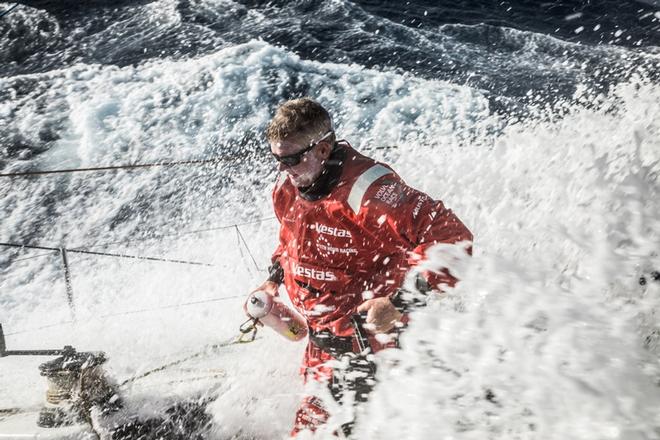Volvo Ocean Race - Seven things you need to know about the Doldrums
by Jonno Turner on 12 Nov 2017

Leg 2 – Lisbon to Cape Town, on board Vestas 11th Hour – Volvo Ocean Race Martin Keruzore / Volvo Ocean Race
The teams have spent the last week hurtling south at breakneck speeds, huge stomach-twisting waves and with buckets of skin–numbing amounts saltwater gushing over the deck.
So far, so Volvo Ocean Race. But there's another landmark on the horizon – and it's time for something altogether different.
Fickle winds coming and going, tropical rain spilling and stuttering from clouds as wide as cities, extreme thunderstorms cracking and warping the skyline – yep, the boats are heading for the Doldrums, well-known by the world's best sailors as an ocean parking lot around the Equator, and which could cause a complete fleet restart in Leg 2.
Here are seven things you need to know about the area which has tortured mariners for centuries...
There's no wind here. The Doldrums is a low pressure area from 5°N to 5°S of the Equator. Winds are famously calm here, with prevailing breeze disappearing altogether at times, making it extremely difficult to navigate through.
It's a place for trade winds to meet other trade winds. The Doldrums is also known as the Inter Tropical Convergence Zone (ITCZ), because it's where two sets of trade winds meet – and that's why conditions can be so shifty. Previously, it was known as the Intertropical Front, but in the 1950s experts discovered the significance of wind field convergence, and renamed it.
It has a bit of a reputation. In fact, a pretty bad one. The Doldrums holds a distinct place in maritime history, having developed a reputation as a potentially deadly zone which could strand ships for weeks on end, causing them to run out of food and drinking water. In those days, with supplies running low, and scurvy setting in, delerium, starvation and cabin fever could all set in – and getting through this mysterious patch of Atlantic Ocean quickly wasn’t just a matter of first or last place, but life and death.
There's science behind it. The effects of the Doldrums are caused by solar radiation from the sun, as sunlight beams down directly on area around the equator. This heating causes the air to warm and rise straight up rather than blow horizontally. The result is little or no wind, sometimes for weeks on end.
It can go from 1 to 100 in seconds. The Doldrums is known for being frustratingly slow, but it’s not just about stagnant calm winds. Often, it can move erratically between different weather patterns including violent thunder and electric storms.
It has nightmare neighbours. It’s preceeded by an area known as the Horse Latitudes. Rumour has it that the area gained its name as Spanish ships transporting horses to their colonies in the West Indies and Americas would often become becalmed here, severely prolonging the voyage and causing water shortages which led to the horses dying, and being thrown overboard.
It's hard to predict. The actual location of the ITCZ gradually varies with the seasons. Over the oceans, the seasonal cycle is subtle, as the convection is constrained by the distribution of ocean temperatures. Sometimes, a double ITCZ forms, with one located north and another south of the Equator, one of which is usually stronger than the other. When this occurs, a narrow ridge of high pressure forms between the two convergence zones.
If you want to link to this article then please use this URL: www.sail-world.com/158742